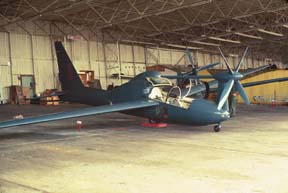
The Lockheed EP-3 is an electronic signals reconnaissance variant of the P-3 Orion, primarily operated by the United States Navy.

The Schweizer Aircraft Corporation was an American manufacturer of sailplanes, agricultural aircraft and helicopters located in Horseheads, New York. It was incorporated in 1939 by three Schweizer brothers, who built their first glider, the SGP 1-1, in 1930. Previously the oldest privately owned aircraft company in the United States, Schweizer was acquired by Sikorsky Aircraft Corporation of Stratford, Connecticut in 2004, and became a diversified aerospace company. Schweizer Aircraft ceased operations in 2012. It was sold to Schweizer RSG in 2018 and production lines were opened in Fort Worth, Texas. The company was producing two helicopter models in 2021. The 300C and 300CBI

The Lockheed YO-3 Quiet Star is an American single-engined, propeller-driven aircraft that was developed for battlefield observation during the Vietnam War. Designed to be as quiet as possible, it was intended to observe troop movements in near-silence during the hours of darkness.

The Fairchild C-26 "Metroliner" is the designation for the Fairchild Swearingen Metroliner series twin turboprop aircraft in the service of the United States military. It was not officially named by the US Armed Forces, but is unofficially known by the same name as its civilian counterpart. The C-26A is the military version of the Model SA227-AC Metro III; the C-26B is the military version of the Model SA227-BC Metro III and Model SA227-DC Metro 23; and UC-26C is the military designation for the Model SA227-AT Merlin IVC. The C-26D provides rapid-response transportation for supplies and personnel to remote airfields.

The Schweizer SGS 1-26 is a United States One-Design, single-seat, mid-wing glider built by Schweizer Aircraft of Elmira, New York.

The Schweizer SGS 1-23 is a United States Open and Standard Class, single-seat, mid-wing glider built by Schweizer Aircraft of Elmira, New York.

The Schweizer SGM 2-37 is a two-place, side-by-side, fixed gear, low wing motor glider.

The Schweizer SGS 2-8 is an American two-seat, mid-wing, strut-braced, training glider built by Schweizer Aircraft of Elmira, New York.

The Schweizer SGS 2-12 is a United States two-seat, low-wing, training glider built by Schweizer Aircraft of Elmira, New York.

The Schweizer SGU 1-19 and Schweizer SGU 1-20 are a family of United States single-seat, high-wing, strut-braced, utility gliders built by Schweizer Aircraft of Elmira, New York.
The Schweizer SGS 1-21 is a United States single-seat, mid-wing, Open Class glider built by Schweizer Aircraft of Elmira, New York.

The Schweizer SGS 1-34 is a United States Standard Class, single-seat, high-wing glider built by Schweizer Aircraft of Elmira, New York.

The Schweizer SGS 2-25 is a United States two-seat, mid-wing, two-place competition glider built by Schweizer Aircraft of Elmira, New York.

The Schweizer SGS 2-32 is an American two-seat, mid-wing, two or three-place glider built by Schweizer Aircraft of Elmira, New York.

The Schweizer SGS 1-35 is a United States 15 Meter Class, single-seat, mid-wing glider built by Schweizer Aircraft of Elmira, New York.

The Schweizer SGS 1-36 Sprite is a United States, single-seat, mid-wing glider built by Schweizer Aircraft of Elmira, New York.

The Schweizer RU-38 Twin Condor is a two or three-seat, fixed gear, low wing, twin boom covert reconnaissance aircraft.

The Ling-Temco-Vought XQM-93 was a remotely piloted aircraft developed in the United States in the late 1960s and early 1970s for use as a communications relay in the Vietnam War. A prototype flew in 1970, but the program was abandoned without producing a service-ready aircraft.
The Martin Marietta Model 845 was a remotely piloted aircraft developed in the United States in the late 1960s and early 1970s for use as a communications relay in the Vietnam War.

The LTV L450F, also known as the L45ØF, was a prototype quiet reconnaissance aircraft, developed by Ling-Temco-Vought in the late 1960s for use in the Vietnam War by the United States. Based on the airframe of a Schweizer 2-32 sailplane, the aircraft flew in 1970, and was developed into the XQM-93 reconnaissance drone before the project was cancelled.




















